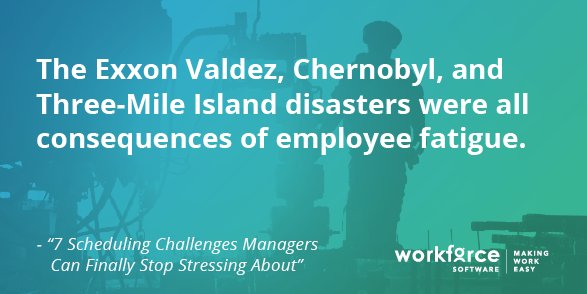This article was originally published on The WorkForce Blog.
“What are the top two challenges your organization faces when scheduling employees?”
We asked this question to nearly 400 workforce leaders responsible for scheduling.
Here’s what they shared with us (plus some concluding advice on how to assuage many, if not all, of these concerns):
1. “Employee complaints about fairness.”
14% of managers consider this a top scheduling challenge.
In the U.S. alone, 17% of employees have unstable work schedules, which are caused, largely, by unfair scheduling practices:
- “On-call” shifts: When managers summon employees for work mere hours before the shift starts, destroying any semblance of work-life balance.
- “Clopening” shifts: When employees are scheduled to close a store and then open it back up the very next morning, which is as exhausting as it sounds.
- “Rotating” shifts: When a single 9-hour shift, for instance, is split into 3-hour sets that are spaced 90 minutes apart.
Of course, shifts like these aren’t only unfair, they’re dangerous.
2. “Employee fatigue.”
19% of managers consider this a top scheduling challenge.
Unfair schedules wear people out. Tired people, then, are more likely to make mistakes: The Exxon Valdez, Chernobyl, and Three-Mile Island disasters were all consequences of employee fatigue.
Tired workers are also late and forgetful, unhappy and unproductive.
3. “Manually processing employee scheduling requests.”
21% of managers consider this a top scheduling challenge.
Effective business leaders do a couple things really well:
- Grow revenue
- Develop people
The more time leaders spend on administrative tasks, the less time they have to devote their talent to scaling people and profits.
4. “Managing budgets.”
29% of managers consider this a top scheduling challenge.
The Department of Labor, rightfully, enforces various laws designed to protect families. In the process, however, the D.O.L. also creates a lot of regulations, red tape that makes budgeting cumbersome, time-consuming, and particularly consequential.
For instance, if an employee’s overtime pay was miscalculated, the employer could be sued for violating the Fair Labor Standards Act.
Violations may not be a problem for small organizations with low employee counts, but larger employers can quickly find themselves bogged down by the details, gasping for breath.
5. “Accurately anticipating scheduling needs.”
32% of managers consider this a top scheduling challenge.
Every year, Chicago’s Lollapalooza music festival floods the downtown with nearly half-a-million people.
Naturally, this influx makes an economic impact, as demand at stores and restaurants and hotels throughout the city goes up.
And while most businesses anticipate a surge in traffic, it’s almost impossible to accurately schedule for it without the benefit of 1) precise data and 2) an algorithm to process it. The consequence is lost revenue.
6. “Filling shifts when unplanned absences occur.”
37% of managers consider this a top scheduling challenge.
DJ, who manages a furniture store, was helping a customer when his phone rang a third time in two minutes. He excused himself and stepped aside.
“Hello, this DJ,” he said. Meanwhile, his customer wandered off.
“Boss!” said a breathless voice. “It’s Peter. My car broke down. I’m waiting for a tow. Sorry…”
“Thanks for the call,” said DJ, as he watched his customer walk out the front door, empty-handed. “I’ll try to find a replacement.” He headed for the back office to make some calls, leaving the sales floor behind.
7. “Maximizing labor productivity.”
33% of managers consider this a top scheduling challenge.
Schedules that put the right people, in the right place, at the right time are, technically, maximizing labor productivity. In other words, they deliver peak ROI. They’re perfect.
But can you imagine what it would take for a person to create a perfect schedule? How many combinations one would have to compute? Every schedule would literally take a lifetime.
To draw a comparison, consider how long it would take a human to analyze the millions of move possibilities that Deep Blue, IBM’s chess-playing computer, processes in a matter of seconds?
Perfect schedules do exist …
They do. Thing is, humans can’t create them… only algorithms can.
Only algorithms can compute and organize that much data so efficiently.
That’s why more and more employers are letting modern workforce management software do the:
- Forecasting: “How many people do I need this week? Next week?”
- Scheduling: “When and where should I/can I use each person?”
This allows leaders to, instead, focus their efforts on developing people and growing revenue.



